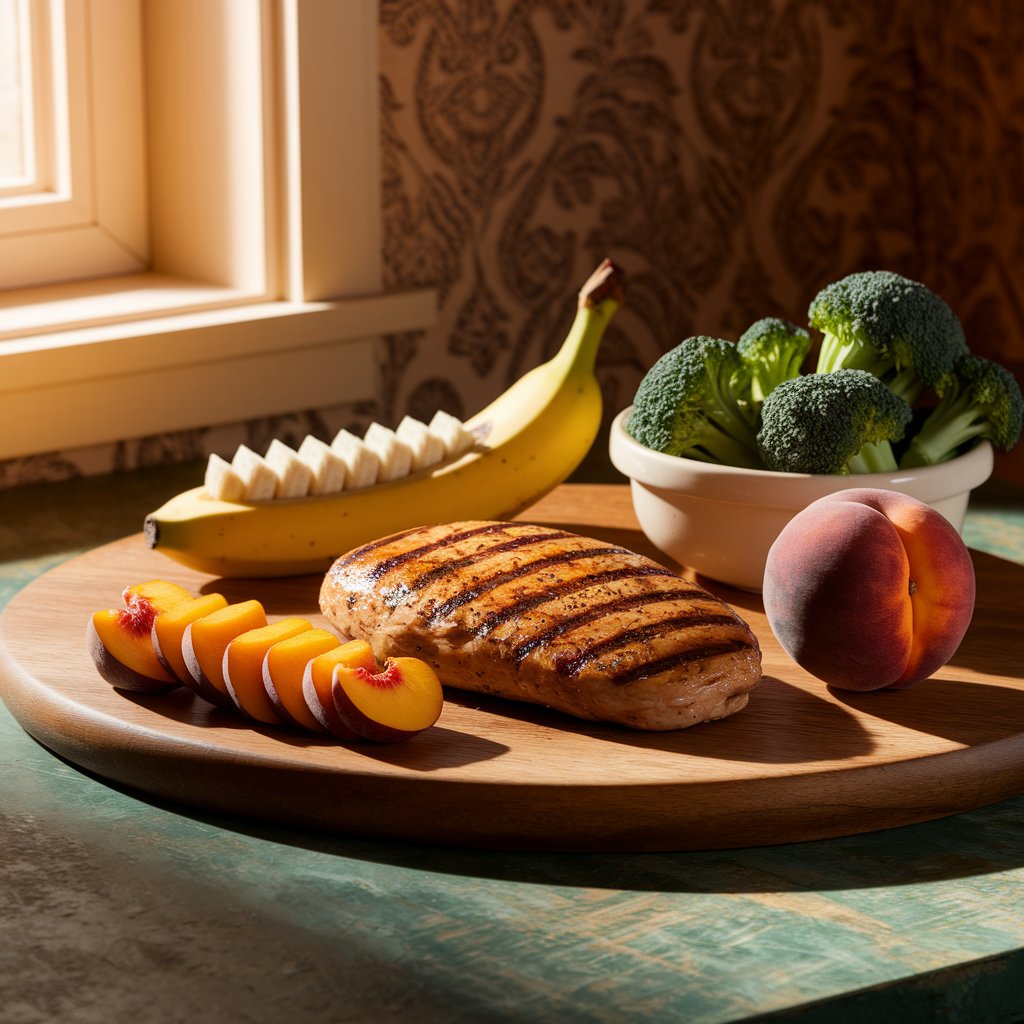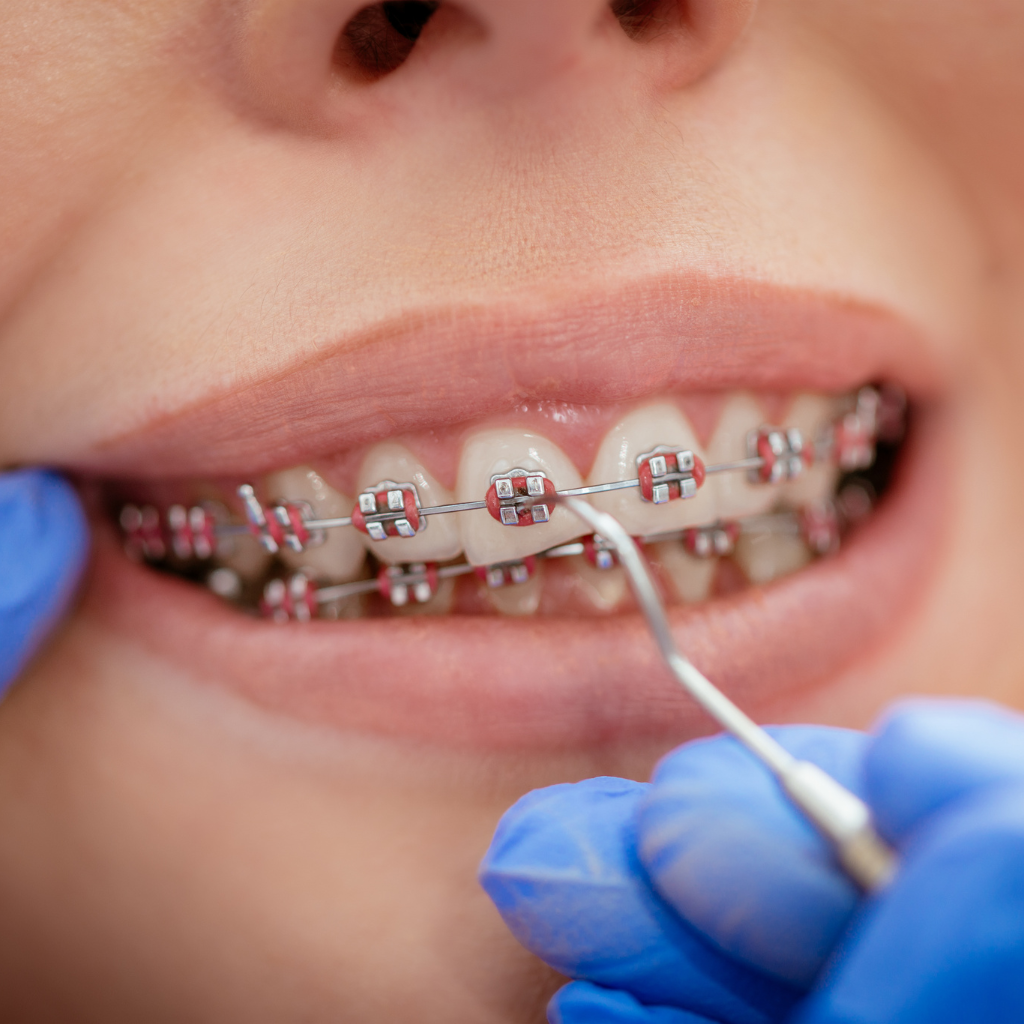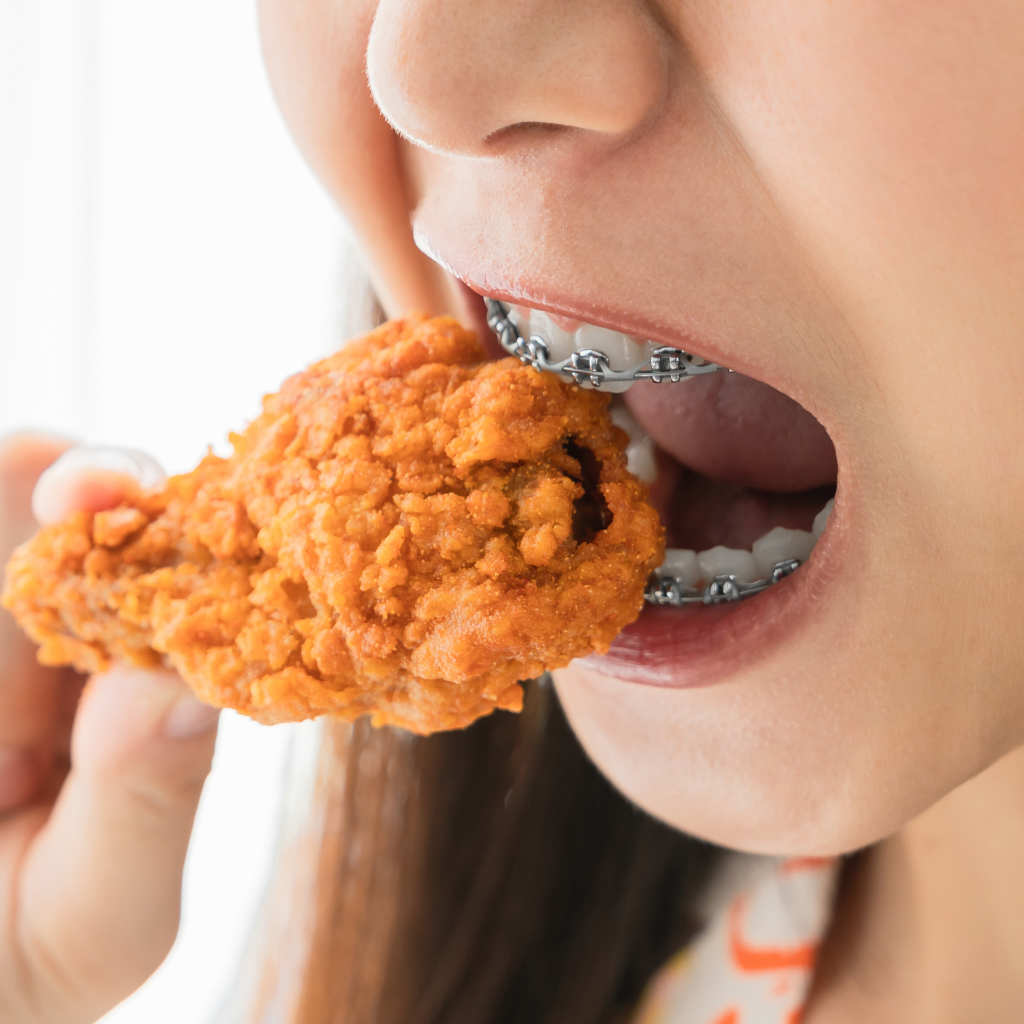After getting braces, soft and gentle foods provide comfort and support dental alignment. Ideal choices include yogurt, mashed potatoes, and scrambled eggs. Bananas and other soft fruits are also beneficial. Initially, it’s essential to avoid sticky, hard, or crunchy foods to prevent damaging the braces. Gradual reintroduction to solid foods can occur within one to two weeks, with careful monitoring for discomfort. Learn more about braces care and dietary guidelines. Additional strategies can optimize the change and maintain oral health effectively.
Key Takeaways
- Choose soft foods like yogurt and mashed potatoes to minimize discomfort after getting braces.
- Soft fruits such as bananas and berries require minimal chewing and are easy on braces.
- Consume cooked vegetables, like steamed carrots, to maintain nutrition without damaging braces.
- Avoid sticky, crunchy, or hard foods to prevent damaging your braces and prolonging treatment.
- Gradually reintroduce solid foods within one to two weeks, monitoring for any discomfort.
What Foods Can You Eat With Braces?
When adjusting to braces, selecting appropriate foods is essential for comfort and oral health.
Soft foods, such as yogurt, mashed potatoes, and scrambled eggs, are recommended to minimize discomfort and avoid damage to the braces.
Identifying the best food options for living with braces guarantees nutritional needs are met while maintaining the integrity of the orthodontic appliances.
Soft Foods to Eat: A Complete List
After getting braces, patients often require a dietary adjustment to guarantee comfort and prevent damage to their orthodontic appliances.
Soft foods are essential for those adjusting to life with braces, as they are gentle on the dental structure and protect the braces. Foods to eat with braces should be easy to chew and pose minimal risk to the brackets and wires.
Suitable foods include soft fruits like bananas, which are not only delicate but also beneficial for oral health. Other foods you can eat are mashed potatoes, yogurt, scrambled eggs, and oatmeal.
These options minimize discomfort and support the dental alignment process. By selecting these types of foods, individuals can efficiently maintain their braces and promote effective orthodontic treatment.
Best Foods for Life with Braces
Steering through the world of food with new braces involves careful selection to guarantee both comfort and appliance integrity.
During the braces journey, identifying the best foods is essential. Soft foods to eat, such as mashed potatoes, yogurt, and scrambled eggs, are recommended as they minimize pain or irritation around brackets.
Eating with braces doesn’t have to be restrictive but requires avoiding certain foods, such as hard candies and nuts, which could necessitate an orthodontist visit to adjust braces.
Foods to eat after getting braces should be easy to chew, reducing stress on brackets.
It is imperative to remain vigilant about foods to avoid maintaining the longevity and effectiveness of the orthodontic treatment, ultimately achieving the desired dental alignment.

How Long After Getting Braces Can You Eat Normally?
In the first few days after getting braces, individuals typically experience discomfort and are advised to consume soft foods to minimize irritation.
As the mouth adjusts and the discomfort subsides, patients can gradually start incorporating more solid foods back into their diet.
Generally, within one to two weeks, most individuals can resume eating a broader range of foods. However, caution with hard or sticky items remains necessary throughout orthodontic treatment.
First Few Days: What to Expect
For individuals newly fitted with braces, the initial few days can present a period of adjustment characterized by discomfort and dietary restrictions.
During this phase, adopting a diet primarily composed of soft food is vital. Eating soft foods like yogurt, mashed potatoes, and smoothies minimizes pressure on new braces, thereby reducing discomfort.
It’s important to avoid foods that can damage braces, such as hard, sticky, or crunchy items. Foods you can’t eat include nuts, popcorn, and chewy candies, as they risk becoming stuck in your braces or causing damage.
Adhering to these dietary guidelines during the early stage of orthodontic treatment not only eases the change but also guarantees the longevity and effectiveness of the braces.
Transitioning to Normal Foods
After the initial adjustment period, the question arises of when it becomes feasible to reintroduce more varied food items into one’s diet with braces. Typically, individuals who get braces can start shifting to normal foods within a few weeks.
During early life with braces, soft foods are recommended to minimize discomfort and the risk of damaging your braces. Soft fruits like bananas and avocados are easy to eat and provide nutritional benefits.
As the gums adapt and discomfort subsides, one may gradually chew firmer foods to eat normally. The key is to introduce these items slowly, while monitoring for any pain or misalignment.
Proper care and caution are essential to guarantee a smooth shift to a regular diet without compromising orthodontic progress.
What Foods Should You Avoid After Getting Braces?
After getting braces, it is essential to avoid certain foods that can compromise the integrity of the orthodontic appliances.
Sticky foods such as chewing gum and caramel can adhere to braces, making them difficult to clean and increasing the risk of damage.
Additionally, crunchy and hard foods like popcorn, nuts, and hard candies should be avoided as they can break brackets and wires, prolonging treatment time.
Foods That Can Damage Your Braces
While adjusting to new braces, it is essential to avoid certain foods that can compromise the integrity of the orthodontic appliances. Sticky foods, such as caramel, can adhere to brackets and wires, leading to potential dislodging or damage to braces.
Hard foods like nuts or popcorn can exert excessive force on the braces, causing them to break. Additionally, sugary foods may lead to plaque buildup, increasing the risk of cavities around brackets.
To prevent damage, consider the following:
- Crunchy foods: Items like chips and pretzels can easily snap wires.
- Chewy foods: Foods such as bagels can tug on brackets, risking detachment.
- Food particles: Small pieces can get stuck in your braces, leading to potential oral health issues.
Avoiding these will help maintain effective orthodontic treatment.
Sticky Foods to Avoid
Braces wearers must exercise caution with sticky foods to prevent compromising their orthodontic treatment. Sticky foods can adhere to brackets and wires, resulting in potential damage to your braces. Such foods can damage orthodontic appliances by exerting undue pressure on your braces. Consequently, certain foods are off-limits for those who wear braces. Foods that can’t be eaten with braces include caramels, taffy, and chewing gum, as they can easily become stuck in the braces.
| Foods to Avoid | Reason | Alternative Option |
|---|---|---|
| Caramels | Sticks to braces | Eating soft fruits |
| Taffy | Exerts pressure on braces | Yogurt |
| Chewing Gum | Gets stuck in braces | Soft cheese |
Opting for alternatives guarantees the integrity of orthodontic treatment and prevents complications.
Crunchy and Hard Foods to Stay Away From
When undergoing orthodontic treatment, patients must be vigilant about avoiding crunchy and hard foods, which pose a significant risk to the structural integrity of braces.
Consuming such foods can damage braces and teeth, resulting in delayed treatment. Getting braces doesn’t mean sacrificing dietary enjoyment, but it does require caution.
Patients can’t eat certain hard foods like nuts and popcorn with braces, which can dislodge the brackets. Foods like these can lead to tooth decay by trapping particles within the braces. As a result, it’s essential to stay away from them.
Here’s a list of foods you can’t eat with braces:
- Nuts: Hard texture can break brackets.
- Popcorn: Kernels get stuck, leading to damage.
- Hard candies: Risk of breaking wires and brackets.
How to Maintain Oral Health With Braces?
Maintaining oral health with braces requires adherence to specific dental hygiene practices, which include thorough brushing and flossing to prevent plaque build-up.
It is vital to address food particles that become lodged in the brackets and wires, as this can lead to tooth decay and gum issues if not properly managed.
Regular visits to the orthodontist are essential for monitoring progress and making necessary adjustments to the braces.

Proper Dental Hygiene Practices
Effective oral hygiene practices are essential for individuals with braces to prevent plaque build-up and guarantee the health of both teeth and gums.
While wearing braces, it is important to navigate foods and drinks carefully to keep the braces clean. Consuming softer foods can minimize damage, while reducing sugary foods and drinks helps prevent gum issues.
Proper dental hygiene practices involve the following:
- Brushing: Use a soft-bristled toothbrush to clean around your braces twice daily, ensuring thorough removal of food particles.
- Flossing: Employ a floss threader to slide dental floss between teeth and wires to maintain gum health.
- Mouthwash: Utilize an antiseptic mouthwash to kill bacteria and strengthen enamel, further supporting oral hygiene.
These measures are significant when learning to eat with braces effectively.
Dealing With Food Particles Stuck in Your Braces
Managing the challenge of food particles trapped in dental braces is essential for maintaining ideal oral health. When individuals first get their braces, they may find that certain favorite foods can’t be enjoyed without difficulty.
Life with braces means making adjustments to dietary habits, ensuring that what they eat is easy on their braces. Tips for eating with braces include selecting softer, normal foods that minimize the risk of trapping food particles. Chewing slowly and cutting food into smaller pieces can help.
Rinsing with water after eating and using orthodontic brushes effectively removes debris. Adopting these practices supports cleanliness and prevents complications.
Regularly addressing food particles is vital for effective oral hygiene and the longevity of the orthodontic treatment.
Visiting Your Orthodontist: What to Expect
When starting on the journey of orthodontic treatment, how often should one visit their orthodontist to ascertain ideal oral health? Regular appointments are essential for people with braces to guarantee a proper fit and adjustment.
Typically, visits are scheduled every 4-6 weeks. Additionally, when choosing the right braces, it’s important to consider options like ceramic vs metal braces, as they may influence comfort, aesthetics, and maintenance throughout treatment.
These appointments allow the orthodontist to:
- Adjust Braces: During the first phase, the orthodontist evaluates the fit and tightens braces to correct alignment.
- Monitor Oral Health: Regular check-ups help detect issues before they worsen, ensuring that solid foods and food in small pieces do not damage the braces.
- Advice on Eating: The orthodontist provides guidance on what foods to avoid and how getting braces can change eating habits during the initial days with braces.
Regular visits optimize treatment effectiveness.
What Are the Tips for Eating With Braces?
When eating with braces, adopting specific chewing techniques can minimize the risk of damage.
It is advisable to avoid exerting excessive pressure on the braces by opting for softer foods and cutting harder items into smaller pieces.
Additionally, selecting foods and drinks that are gentle on the brackets and wires can guarantee a safer and more comfortable dining experience.
Chewing Techniques to Protect Your Braces
Adopting effective chewing techniques is essential to safeguarding braces and ensuring treatment progresses smoothly. During the first week with braces, individuals often experience discomfort and cannot eat certain foods.
It’s vital to avoid placing much stress on braces by choosing the right foods and employing careful chewing methods. This will facilitate eating a variety of foods, including plenty of foods, long after getting braces.
Here are three key chewing techniques:
- Cut food into smaller pieces: This minimizes the risk of damaging brackets and wires.
- Chew slowly and gently: This prevents undue pressure on braces and aids digestion.
- Use back teeth: Focusing on molars reduces strain on front braces, protecting them from potential damage.
These techniques help maintain the integrity of braces throughout treatment.
Avoiding Pressure on Your Braces While Eating
Successfully managing the adjustment to braces involves understanding and implementing strategies to avoid unnecessary pressure on them while eating. Ensuring that braces don’t incur damage begins with selecting appropriate foods. A list of foods that are soft and non-sticky is essential. Options such as yogurt, mashed potatoes, and steamed vegetables provide nutrition without undue strain.
Cutting foods into smaller pieces is another effective strategy to distribute bite force evenly, reducing impact on the brackets. Additionally, caution is advised against using teeth to bite into hard items like apples or corn on the cob. Instead, slicing them into manageable portions is recommended.
Orthodontists often recommend that braces wearers to chew slowly and mindfully, fostering a gentle approach that safeguards the structural integrity of the braces.

Foods and Drinks to Enjoy Safely
Maneuvering the dietary landscape with braces necessitates careful selection of foods and drinks to minimize damage and discomfort. Opting for soft, non-sticky options can prevent bracket damage and wire dislodgement.
Recommended consumables include:
- Dairy Products: Yogurt and cheese provide calcium and protein while being gentle on braces.
- Cooked Vegetables: Steamed or boiled vegetables like carrots and broccoli are tender and pose no threat to orthodontic appliances.
- Soft Fruits: Bananas and berries are nutritious and do not require excessive chewing, reducing stress on dental hardware.
Hydration is critical; water is the best beverage, promoting oral hygiene and preventing sugar-related plaque formation. Avoid acidic drinks like soda, which can erode enamel and irritate sensitive areas. Adhering to these guidelines guarantees a safe, comfortable eating experience with braces.
Conclusion
In summary, managing dietary choices after getting braces is vital for comfort and oral health. Initially, soft foods like yogurt, mashed potatoes, and smoothies are recommended to ease discomfort and protect orthodontic appliances. Gradually reintroducing firmer foods is possible as adjustment occurs. Avoiding hard, sticky, or chewy items prevents damage to braces. Maintaining oral hygiene through meticulous cleaning is important to prevent complications. By adhering to these guidelines, individuals can guarantee both effective treatment and the best oral health.


